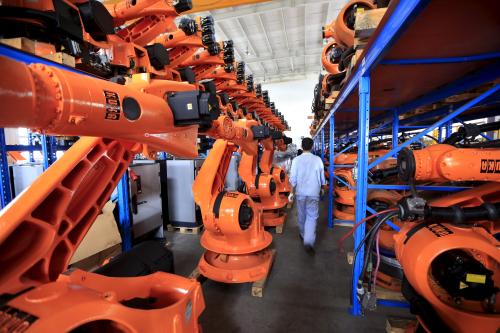We’ve talked about the future of work before in this space and the research we summarized was highly variable—from dire predictions of job losses from automation to technology optimists asking “why should it be different this time?”
Here are four fresh takes on the subject. Unlike before, these pieces have a fair amount in common. They all agree that the question about whether (and how many) jobs will be killed by automation is the wrong question and probably unanswerable. They then move towards more interesting questions.
McAfee and Brynjolfsson pose two different questions. First, they worry that automation has a pronounced impact on very specific types of jobs, rather than on jobs in the aggregate. They find that the number of hours worked in the U.S. continues to increase. The problem, in their view, is that routine jobs that are the basis of middle-class wages (the example they give is payroll handling in a factory) are being rapidly automated and this is pushing down wages for this segment of the labor force. This is consistent with other work showing a U-shape when job growth is plotted against wage level—high wage jobs and low wage jobs are increasing, but mid-wage jobs are falling.
Their second worry is about reduced work among specific groups, as evidenced for example by the fact that 16 percent of U.S. men between the ages of 25 and 54 with a high school education or less have dropped out of the workforce completely.
Their solutions: address low-wage issues through policies like the Earned Income Tax Credit, and figure out what kinds of jobs might be taken up by underutilized parts of the workforce—so they advocate for infrastructure construction for the aforementioned middle-aged men.
Acemoglu and Restrepo make a similar point—that the issue is not job losses but a change in the nature of work. They demonstrate that employment goes up in occupations where the number of job titles is larger, in other words where there is a finer division of labor. They then show that the rate of new job titles has been growing along with automation. They develop a theoretical construct of endogenous automation to explain why technology can lead to lower wages and increase inequality, but also to suggest that there may stabilizing forces that bring this process into equilibrium as wages adjust. In other words, wage and employment movements should not just be considered as trends that simply continue into the future, but as dynamic processes of adjustment from one steady state to another.
A less technical overview by James Manyika of the McKinsey Global Institute highlights that the proportion of occupations that can be fully automated is less than 5 percent, but in 60 percent of occupations at least 30 percent of activities are technically automatable. For him, the issue is how to adapt to and utilize new technology, not whether new technology will displace people. He adds that technology can play a significant role in talent matching platforms, skills development and expanding the gig economy, all of which helps improve the labor market and leads to rising wages.
Mahdawi has a useful categorization of occupations that are relatively safe from automation: Creatives, of course, but also occupations involving human relationships (caregivers) and those that deal with unpredictable events and on the job problems (plumbers). The most at-risk occupation—telemarketer. I doubt many will miss those.
These writings all have a relatively positive impression of automation, a welcome contrast from the hysteria of old. So while you grill on this Fourth of July weekend, remember that there is already a robot called Flippy that is making the perfect burger in CaliBurger restaurants. Is that progress, or what?
The Brookings Institution is committed to quality, independence, and impact.
We are supported by a diverse array of funders. In line with our values and policies, each Brookings publication represents the sole views of its author(s).







Commentary
Future Development Reads: Is automation a threat?
June 30, 2017